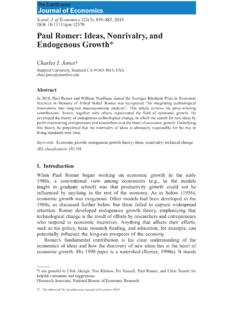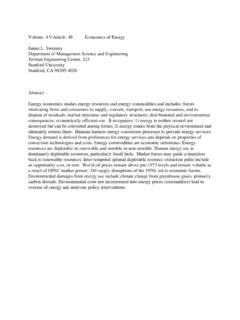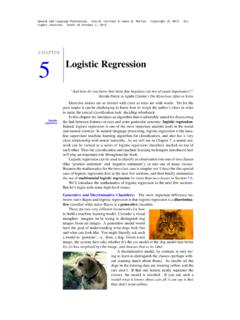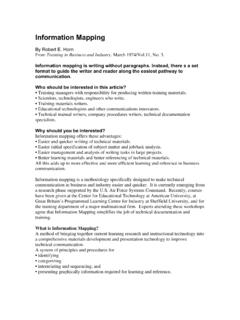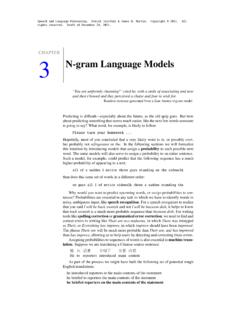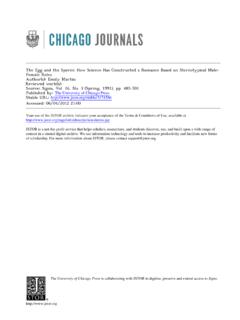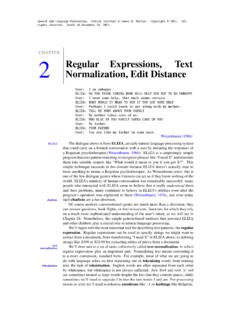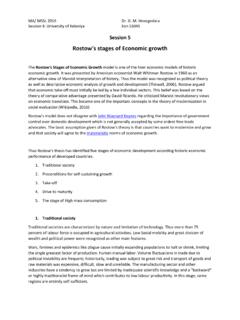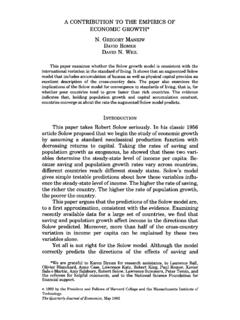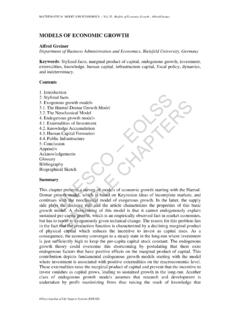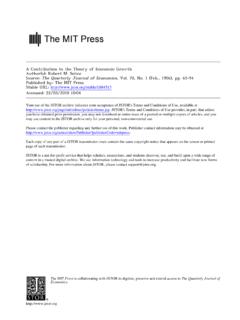Transcription of THE CLASSICAL THEORY OF ECONOMIC GROWTH
1 THE CLASSICAL THEORY OF ECONOMIC GROWTH Donald J. Harris Professor of Economics, Emeritus Stanford University February 20, 2007 Forthcoming in The New Palgrave Dictionary of Economics, 2nd edition, London: Macmillan, 2007. 1 THE CLASSICAL THEORY OF ECONOMIC GROWTH Donald J. Harris Abstract Focused on the emerging conditions of industrial capitalism in Britain in their own time, the CLASSICAL economists were able to provide an account of the broad forces that influence ECONOMIC GROWTH and of the mechanisms underlying the GROWTH process.
2 accumulation and productive investment of a part of the social surplus in the form of profits were seen as the main driving force. Hence, changes in the rate of profit were a decisive reference point for analysis of the long-term evolution of the economy. As worked out most coherently by Ricardo, the analysis indicated that in a closed economy there is an inevitable tendency for the rate of profit to fall. In this article, the essential features of the CLASSICAL analysis of the accumulation process are presented and formalized in terms of a simple model.
3 CLASSICAL Perspectives on GROWTH Analysis of the process of ECONOMIC GROWTH was a central feature of the work of the English CLASSICAL economists, as represented chiefly by Adam Smith, Thomas Malthus and David Ricardo. Despite the speculations of others before them, they must be regarded as the main precursors of modern GROWTH THEORY . The ideas of this school reached their highest level of development in the works of Ricardo. The interest of these economists in problems of ECONOMIC GROWTH was rooted in the concrete conditions of their time. Specifically, they were confronted with the facts of ECONOMIC and social changes taking place in contemporary English society as well as in previous historical periods.
4 Living in the 18th and 19th centuries, on the eve or in the full throes of the industrial revolution, they could hardly help but be impressed by such changes. They undertook their investigations against the background of the emergence of what was to be regarded as a new ECONOMIC system the system of industrial capitalism. Political economy represented a conscious effort on their part to develop a scientific explanation of the forces governing the operation of the ECONOMIC system, of the actual processes involved in the observed changes that were going on, and of the long-run tendencies and outcomes to which they were leading.
5 The interest of the CLASSICAL economists in ECONOMIC GROWTH derived also from a philosophical concern with the possibilities of progress an essential condition of which was seen to be the development of the material basis of society. Accordingly, it was felt that the purpose of analysis was to identify the forces in society that promoted or hindered this development, and hence progress, and consequently to provide a basis for policy and action to influence those forces. Ricardo s campaign against the Corn Laws must obviously be seen in this light, as also Malthus s concern with the problem of population GROWTH and Smith s attacks against the monopoly privileges associated with mercantilism.
6 Of course, for these economists, Smith especially, progress was seen from the point of view of the GROWTH of national wealth. Hence, the principle of national advantage was 2 regarded as an essential criterion of ECONOMIC policy. Progress was conceived also within the framework of a need to preserve private property and hence the interests of the property-owning class. From this perspective, they endeavoured to show that the exercise of individual initiative under freely competitive conditions to promote individual ends would produce results beneficial to society as a whole.
7 Conflicting ECONOMIC interests of different groups could be reconciled by the operation of competitive market forces and by the limited activity of responsible government. As a result of their work in ECONOMIC analysis the CLASSICAL economists were able to provide an account of the broad forces that influence ECONOMIC GROWTH and of the mechanisms underlying the GROWTH process. An important achievement was their recognition that the accumulation and productive investment of a part of the social product is the main driving force behind ECONOMIC GROWTH and that, under capitalism, this takes the form mainly of the reinvestment of profits.
8 Armed with this recognition, their critique of feudal society was based on the observation among others, that a large part of the social product was not so invested but was consumed unproductively. The explanation of the forces underlying the accumulation process was seen as the heart of the problem of ECONOMIC GROWTH . Associated with accumulation is technical change as expressed in the division of labour and changes in methods of production. Smith, in particular, placed heavy emphasis on the process of extension of division of labour, but there is, in general, no systematic treatment of the relation between capital accumulation and technical change in the work of the CLASSICAL economists.
9 It later becomes a pivotal theme in the work of Marx and is subjected there to detailed analysis (see, for instance, Capital, I, part 4). To these basic forces in ECONOMIC GROWTH they added the increase in the supply of labour available for production through GROWTH of population. Their analysis of the operation of these forces led them to the common view, though they quite clearly differed about the particular causes, that the process of ECONOMIC GROWTH under the conditions they identified raises obstacles in its own path and is ultimately retarded, ending in a state of stagnation the stationary state.
10 The conception of the stationary state as the ultimate end of the process of ECONOMIC GROWTH is often interpreted as a prediction of the actual course of ECONOMIC development in 19th-century England. There is no doubt that it was for a time so regarded by some, if not all, of the economists and their contemporaries, though the weight that was assigned to this particular aspect of the conception by Ricardo himself is a matter of some dispute. What is more significant, however, is that this conception served to point to a particular social group, the landlord class, who benefited from the social product without contributing either to its formation or to progress and who, by their support of the corn laws and associated restrictions on foreign trade, acted as an obstacle to the only effective escape from the path to a stationary state, that is, through foreign trade.
